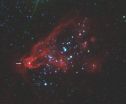(Press-News.org) Human impact on Earth produces a unique kind of biosphere
Changes to life may be the greatest for the past half billion years
Earth may be entering a new kind of planetary state
Human beings are pushing the planet in an entirely new direction with revolutionary implications for its life, a new study by researchers at the University of Leicester has suggested.
The research team led by Professor Mark Williams from the University of Leicester's Department of Geology has published their findings in a new paper entitled 'The Anthropocene Biosphere' in The Anthropocene Review.
Professor Jan Zalasiewicz from the University of Leicester's Department of Geology who was involved in the study explained the research: "We are used to seeing headlines daily about environmental crises: global warming, ocean acidification, pollution of all kinds, looming extinctions. These changes are advancing so rapidly, that the concept that we are living in a new geological period of time, the Anthropocene Epoch - proposed by the Nobel Prize-winning atmospheric chemist Paul Crutzen - is now in wide currency, with new and distinctive rock strata being formed that will persist far into the future.
"But what is really new about this chapter in Earth history, the one we're living through? Episodes of global warming, ocean acidification and mass extinction have all happened before, well before humans arrived on the planet. We wanted to see if there was something different about what is happening now."
The team examined what makes the Anthropocene special and different from previous crises in Earth's history. They identified four key changes:
The homogenisation of species around the world through mass, human-instigated species invasions - nothing on this global scale has happened before
One species, Homo sapiens, is now in effect the top predator on land and in the sea, and has commandeered for its use over a quarter of global biological productivity. There has never been a single species of such reach and power previously
There is growing direction of evolution of other species by Homo sapiens
There is growing interaction of the biosphere with the 'technosphere' - a concept pioneered by one of the team members, Professor Peter Haff of Duke University - the sum total of all human-made manufactured machines and objects, and the systems that control them
In total, the team suggests that these changes represent a planetary transformation as fundamental as the one that saw the evolution of the photosynthetic microbes which oxygenated the planet 2.4 billion years ago, or that saw the transition from a microbial Earth to one dominated by multicellular organisms half a billion years ago.
Professor Williams added: "We think of major changes to the biosphere as the big extinction events, like that which finished off the dinosaurs at the end of the Cretaceous Period. But the changes happening to the biosphere today may be much more significant, and uniquely are driven by the actions of one species, humans."
INFORMATION:
The team includes Professor Mark Williams and Jan Zalasiewicz (University of Leicester), Peter Haff (Duke University, USA), Christian Schwägerl (Aßmannshauser Strasse 17, Berlin, Germany), Anthony D Barnosky (University of California, USA) and Erle C Ellis (University of Maryland, Baltimore County, USA).
The paper 'The Anthropocene Biosphere' is published in The Anthropocene Review and is available here: http://anr.sagepub.com/content/early/2015/06/17/2053019615591020.abstract?patientinform-links=yes&legid=spanr;2053019615591020v1
Images of the growing global technosphere and Professors Mark Williams and Jan Zalasiewicz available at: https://www.dropbox.com/sh/ojdocgdy0pk4qld/AACEbF6Nbe_hDgL6lmM1tTXva?dl=0
A new study of 33 Kepler stars with solar-like oscillations to be published in Monthly Notices of the Royal Astronomical Society. The 33 Kepler stars have been selected for their solar like oscillations and a set of basic parameters have been determined with high precision showing that stars even older than 11 billion years have Earth-like planets.
According to lead author of the article Victor Silva Aguirre from the Stellar Astrophysics Centre at Aarhus University, Denmark: " Our team has determined ages for individual host stars before with similar levels of accuracy, ...
Marijuana is the most prevalent drug in the U.S. Approximately 70% of the 2.8 million individuals who initiated use of illicit drugs in 2013 reported that marijuana was their first drug. Despite extensive research examining potential links between marijuana use and other drug use, the literature is currently lacking data regarding which illicit marijuana users are most likely to engage in use of other illicit drugs.
A new study, published in the American Journal of Drug and Alcohol Abuse by researchers affiliated with New York University's Center for Drug Use and HIV ...
Using the Subaru Telescope, researchers at the Special Astrophysical Observatory in Russia and Kyoto University in Japan have found evidence that enigmatic objects in nearby galaxies - called ultra-luminous X-ray sources (ULXs) - exhibit strong outflows that are created as matter falls onto their black holes at unexpectedly high rates. The strong outflows suggest that the black holes in these ULXs must be much smaller than expected. Curiously, these objects appear to be "cousins" of SS 433, one of the most exotic objects in our own Milky Way Galaxy. The team's observations ...
New research from the University of Exeter has shown that the sexually antagonistic gene for resistance to the pesticide DDT, which increases fitness in female flies but simultaneously decreases fitness in male flies, helps to maintain genetic variation. The findings contribute to the understanding of evolutionary dynamics and have important implications for pest management.
The researchers used a genetic model and multiple experimentally evolving populations of the fly Drosophila melanogaster to test whether sexual conflict can maintain genetic variation. Their findings ...
University of Southampton scientists have discovered a link between coronary heart disease and osteoporosis, suggesting both conditions could have similar causes.
In one of the first studies of its kind to use a special scanning technique, researchers found that people with a history of heart disease had substantially lower cortical volumetric bone mineral density in their wrist bone (the distal radius) than those without.
Using a state-of-the-art technique called 'high resolution peripheral quantitative computed tomography', researchers from Southampton's Medical Research ...
MELBOURNE, FLA. -- A new study led by Florida Institute of Technology Professor Ningyu Liu has improved our understanding of a curious luminous phenomenon that happens 25 to 50 miles above thunderstorms.
These spectacular phenomena, called sprites, are fireworks-like electrical discharges, sometimes preceded by halos of light, in earth's upper atmosphere. It has been long thought that atmospheric gravity waves play an important role in the initiation of sprites but no previous studies, until this team's recent findings, provided convincing arguments to support that idea. ...
New research identifies the types of investors who are vigilant about corporate fraud, but finds that most of those investors are tracking the wrong red flags - meaning the warning signs they look for are clear only after it's too late to protect their investment. The work was performed by researchers at North Carolina State University, George Mason University, the University of Virginia and the University of Cincinnati.
"Individual investors get hurt if they own stock in fraudulent companies that cook the books, such as Enron," says Dr. Joe Brazel, a professor of accounting ...
This news release is available in Spanish. A technique to increase the flow of blood from the umbilical cord into the infant's circulatory system improves blood pressure and red blood cell levels in preterm infants delivered by Cesarean section, according to a study funded by the National Institutes of Health.
The study, published online in Pediatrics, was conducted by researchers at the Neonatal Research Institute at Sharp Mary Birch Hospital for Women and Newborns in San Diego, and Loma Linda University, Loma Linda, Calif. It was supported by NIH's Eunice Kennedy ...
Boston, MA -- Longer secondary schooling substantially reduces the risk of HIV infection--especially for girls--and could be a very cost-effective way to halt the spread of the virus, according to researchers from Harvard T.H. Chan School of Public Health. In a study in Botswana, researchers found that, for each additional year of secondary school, students lowered their risk of HIV infection by 8 percentage points about a decade later, from 25% to about 17% infected.
"These findings confirm what has been fiercely debated for more than two decades--that secondary schooling ...
Longer secondary schooling substantially reduces the risk of contracting HIV, particularly for girls, according to new research from Botswana published in The Lancet Global Health journal. The researchers estimate that pupils who stayed in school for an extra year of secondary school had an 8 percentage point lower risk of HIV infection about a decade later, from about 25% to about 17% infected.
The study, which also shows expanding secondary schooling to be a very cost effective HIV prevention measure, used a recent school policy reform as a 'natural experiment' to ...




